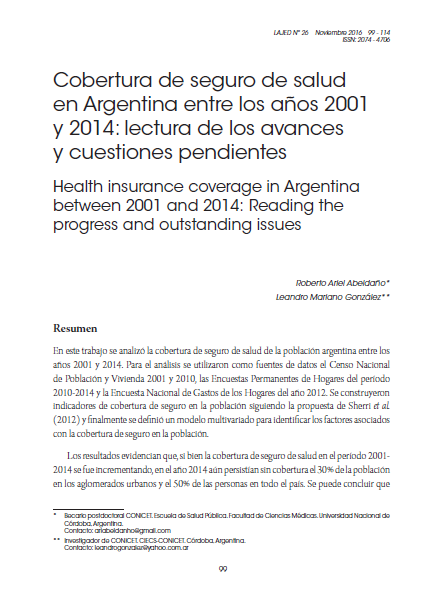Health insurance coverage in Argentina between 2001 and 2014: Reading the progress and outstanding issues
DOI:
https://doi.org/10.35319/lajed.20162659Keywords:
Universal Health Coverage, Health system, Public healthAbstract
This paper aims to analyze the health insurance coverage of Argentina’s population between 2001 and 2014. For analysis were used the data included in the National Population and Housing Census 2001 and 2010, the Permanent Household Surveys 2010-2014 and the National Survey of Household Expenditure 2012. Indicators of insurance coverage of the population were constructed following the proposal of Sherri et al. (2012) and finally a multivariate model was defined to identify associated factors with insurance coverage of the population.
The results show that although the health insurance coverage in the period 2001-2014 was increased, in 2014 still persisted without cover 30% of the population in urban areas and 50% of people around the country. It can be concluded that there are differential related to geographical factors and social factors on coverage of health insurance.
Downloads
References
Argentina, Ministerio de Salud de la Nación. Programa Remediar. 2013. “Impacto redistributivo del programa remediar en el gasto en medicamentos”. Disponible en: www.remediar.gov.ar
Banco Mundial. 2013. Datos del Banco Mundial. Disponible en http://datos.bancomundial.org/indicador/SH.TBS.INCD/countries
Cavegnero, E. y M. Bilger. 2010. “Equity during an economic crisis: financing of the Argentine health system”. Journal of Health Economics, 29(4), 479-488.
Castro, J. 2009. “Hacia el aseguramiento universal en salud en el Perú”. Rev Peru Med Exp Salud Pública, 26(2), 232-35.
Drachler, M.L., Marcos Antônio de Oliveira Lobato, José Inácio Lermen, Sandra Fagundes et al. 2014. “Desenvolvimento e validação de um índice de vulnerabilidade social aplicado a políticas públicas do SUS”. Ciência & Saúde Coletiva, 19(9):3849-3858.
Fleury, S. y C. Molina. 2002. “Modelos de protección social”. En: Banco Interamericano de Desarrollo, Instituto Interamericano para el Desarrollo Social (INDES): Diseño y gerencia de políticas y programas sociales. Washington: INDES.
Frenz, P., I. Becerra, L. Villanueva, J. Kaufman, F. Muñoz Porras et al. 2013. “Seguimiento de cobertura sanitaria universal con equidad en Chile entre 2000 y 2011 usando las encuestas CASEN”. Revista Médica de Chile, 141(9),1095-1106
Golovanevski, L. 2007. “Vulnerabilidad y transmisión intergeneracional de la pobreza. Un abordaje cuantitativo para Argentina en el siglo XXI”. Tesis Doctoral. Doctorado en Economía. Buenos Aires: Universidad de Buenos Aires.
Instituto Nacional de Estadísticas y Censos (INDEC). Encuesta Permanente de Hogares. Disponible en www.indec.gov.ar
Kessler, G. 2014. Controversias sobre la desigualdad. Argentina, 2003-2013. Buenos Aires: Fondo de Cultura Económica.
Martínez, D. y M.L. Vega. 2001. La globalización gobernada. Estado, sociedad y mercado en el siglo XXI. Madrid: Editorial Tecnos (Grupo Anaya).
Mesa-Lago, C. 2000. Desarrollo social, Reforma del Estado y de la seguridad social al umbral del siglo XXI. Serie Políticas Sociales Nº 36. Santiago de Chile: CEPAL/ECLAC. 114
Núñez, P. 2015. “Investigación sobre resultados del Plan Nacer/Programa SUMAR”. Biblioteca de investigaciones y estudios del Programa Sumar. Disponible en http:// www.msal.gob.ar/sumar/index.php/institucional/biblioteca-de-investigaciones-yestudios-del-programa-sumar
OMS. 2008. Informe sobre la salud en el mundo 2008: la atención primaria de salud, más necesaria que nunca. Ginebra: OMS. Disponible en: http: //www.who.int/ whr/2008/08_report_es.pdf.
OPS-OMS. 2014a. Resolución Nº53 Consejo Directivo 66ª Sesión del Comité Regional de la OMS para las Américas. Washington, D.C., EUA.
OPS-OMS. 2014b. Estrategia para el acceso universal a la salud y la cobertura universal de salud. 66ª Sesión del Comité Regional de la OMS para las Américas. Washington, D.C., EUA.
Scheil-Adlung, X., F. Bonnet, T. Wiechers y T. Ayangbayi. 2010. “New approaches to measuring deficits in social health protection coverage in vulnerable countries”. World Health Report. Background Paper Nº 56. WHO.
Sherri, H., L. Hatt, A. Leegwater, M. El-Khoury y W. Wong. 2012. Indicators for Measuring Universal Health Coverage: A Five-Country Analysis (draft). Bethesda, MD: Health Systems 20/20 project, Abt Associates Inc.
Sojo, A. 2003. “Vulnerabilidad social, aseguramiento y diversificación de riesgos en América Latina y el Caribe”. Revista CEPAL, 80: 121-140
The World Health Report (WHO). 2010. Health Systems Financing : The path to universal coverage. Geneva: World Health Organization.
Titelman, D. y A. Uthoff. 2003. “El papel del aseguramiento en la protección social”. Revista CEPAL, 81:103-122.






